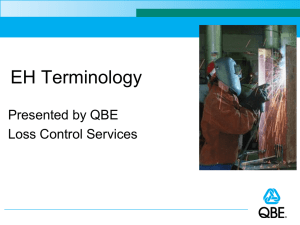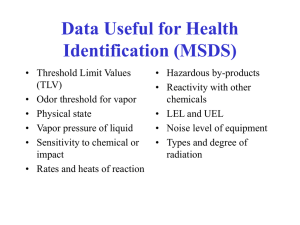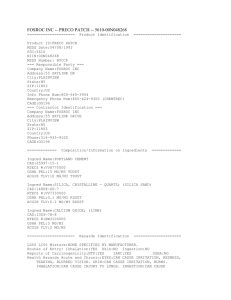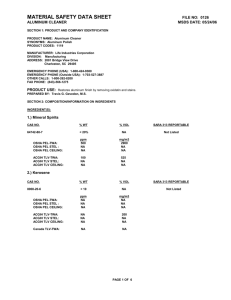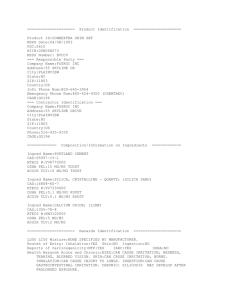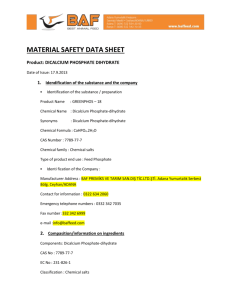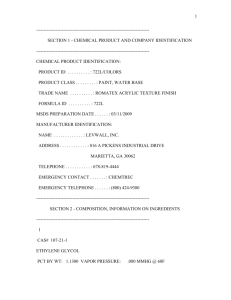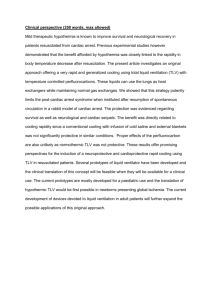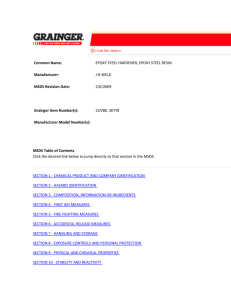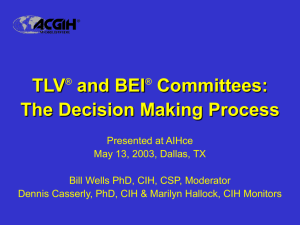Now - Chemical Processing
advertisement
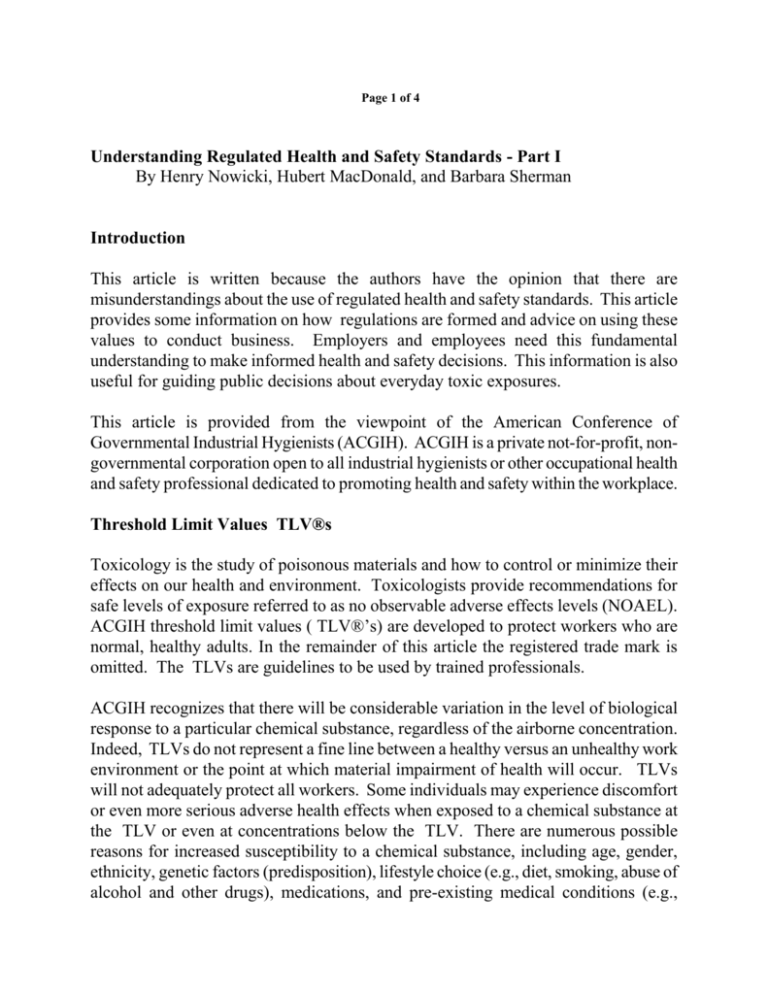
Page 1 of 4 Understanding Regulated Health and Safety Standards - Part I By Henry Nowicki, Hubert MacDonald, and Barbara Sherman Introduction This article is written because the authors have the opinion that there are misunderstandings about the use of regulated health and safety standards. This article provides some information on how regulations are formed and advice on using these values to conduct business. Employers and employees need this fundamental understanding to make informed health and safety decisions. This information is also useful for guiding public decisions about everyday toxic exposures. This article is provided from the viewpoint of the American Conference of Governmental Industrial Hygienists (ACGIH). ACGIH is a private not-for-profit, nongovernmental corporation open to all industrial hygienists or other occupational health and safety professional dedicated to promoting health and safety within the workplace. Threshold Limit Values TLV®s Toxicology is the study of poisonous materials and how to control or minimize their effects on our health and environment. Toxicologists provide recommendations for safe levels of exposure referred to as no observable adverse effects levels (NOAEL). ACGIH threshold limit values ( TLV®’s) are developed to protect workers who are normal, healthy adults. In the remainder of this article the registered trade mark is omitted. The TLVs are guidelines to be used by trained professionals. ACGIH recognizes that there will be considerable variation in the level of biological response to a particular chemical substance, regardless of the airborne concentration. Indeed, TLVs do not represent a fine line between a healthy versus an unhealthy work environment or the point at which material impairment of health will occur. TLVs will not adequately protect all workers. Some individuals may experience discomfort or even more serious adverse health effects when exposed to a chemical substance at the TLV or even at concentrations below the TLV. There are numerous possible reasons for increased susceptibility to a chemical substance, including age, gender, ethnicity, genetic factors (predisposition), lifestyle choice (e.g., diet, smoking, abuse of alcohol and other drugs), medications, and pre-existing medical conditions (e.g., aggravation of asthma or cardiovascular disease). Some individuals may become more responsive to one or more chemical substances following previous exposures (e.g., sensitized workers). Susceptibility to the effects of chemical substances may be altered during different periods of fetal development and throughout an individual’s reproductive lifetime. Some changes in susceptibility may also occur at different work levels (e.g., light versus heavy work) or at exercise - situations in which there is increased cardiopulmonary demand. Additionally, variations in temperature (e.g., extreme heat or cold) and relative humidity may alter an individual’s response to a toxicant. The Documentation for any TLV must be reviewed, keeping in mind that other factors may modify biological responses. Three categories of TLVs are specified: time-weighted average (TWA); short-term exposure limit (STEL); and a Ceiling (C). For most substances, a TWA alone or with a STEL is relevant. For some substances (e.g., irritant gases), only the TLV-Ceiling is applicable. If any of these TLV types are exceeded, a potential hazard from that substance is presumed to exist. Threshold Limit Value-Time Weighted Average ( TLV-TWA): The TWA concentration for a conventional 8-hour workday and a 40-hour workweek, to which it is believed that nearly all workers may be repeatedly exposed, day after day, for a working lifetime without adverse effect. Although calculating the average concentration for a workweek, rather than a workday, may be appropriate in some instances, ACGIH does not offer guidance regarding weekly exposures. Threshold Limit Value-Short-Term Exposure Limit ( TLV-STEL): A 15-minute TWA exposure that should not be exceeded at any time during a workday, even if the 8-hour TWA is within the TLV-TWA. The TLV-STEL is the concentration to which it is believed that workers can be exposed continuously for a short period of time without suffering from 1) irritation, 2) chronic or irreversible tissue damage, 3) dose-rate-dependent toxic effects, or 4) narcosis of sufficient degree to increase the likelihood of accidental injury, impaired self-rescue, or materially reduced work efficiency. The TLV-STEL will not necessarily protect against these effects if the daily TLV-TWA is exceeded. The TLV-STEL is not a separate, independent exposure guideline; rather, it supplements the TLV-TWA where there are recognized acute effects from a substance whose toxic effects are primarily of a chronic nature. Exposures above the TLV-TWA up to the TLV-STEL should be less than 15 minutes, should occur less than four times per day, and there should be at least 60 minutes between successive exposure in this range. An averaging period other than 15 minutes may be recommended when this is warranted by observed biological effects. Threshold Limit Value-Ceiling ( TLV-C): The concentration that should not be exceeded during any part of the working exposure. If instantaneous measurements are not available, sampling should be conducted for a minimum period of time sufficient to detect exposures at or above the ceiling value. ACGIH believes that TLVs based on physical irritation should be considered evidence that physical irritation may initiate, promote, or accelerate adverse health effects through interaction with other chemical or biological agents or through other mechanisms. TLV-C is Appropriate A substance may have certain toxicological properties that require the use of TLV-C instead of TLV-TWA or TLV-STEL. Amount by which TLVs may be exceeded for short periods without injury to health depends upon a number of factors. All factors must be taken into consideration. 1) nature of the contaminant 2) whether very high concentrations - even for short periods produce acute poisoning, 3) whether the effects are cumulative, 4) frequency with which high concentrations occur 5) duration of such exposure periods TWA is Not Appropriate TLV-C is sometimes more appropriate that TLV-TWA. There are certain substances for which TWA is inappropriate, this group characteristics are: 1) fast acting, 2) TLV is more appropriatley based on fast acting, 3) TLV-C should not be exceeded for fast acting, TLV-C places a definite boundary that exposure concentration should not be permitted to exceed. TLV-TWA requires an explicit limit to the excursions which are acceptable above the recommended TLV-TWAs. TWA and STEL Versus Ceiling (C) A substance may have certain toxicological properties that require the use of a TLV-C rather than a TLV-TWA excursion limit or a TLV-STEL. The amount by which the TLVs may be exceeded for short periods without injury to health depends upon a number of factors such as the nature of the contaminant, whether very high concentrations - even for short periods - produce acute poisoning, whether the effects are cumulative, the frequency with which high concentrations occur, and the duration of such periods. All factors must be taken into consideration in arriving at a decision as to whether a hazardous condition exists. Although the TWA concentration provides the most satisfactory, practical way of monitoring airborne agents for compliance with the TLVs, there are certain substances for which it is inappropriate. In the latter group are substances that are predominantly fast-acting and whose TLV is more appropriately based on this particular response. Substances with this type of response are best controlled by a TLV-C that should not be exceeded. It is implicit in these definitions that the manner of sampling to determine noncompliance with the TLVs for each group must differ. Consequently, a single, brief sample that is applicable to a TLV-C is not appropriate to the TLV-TWA; here, a sufficient number of samples are needed to permit determination of a TWA concentration throughout a complete cycle of operation or throughout the workshift. The TLV-C places a definite boundary that exposure concentrations should not be permitted to exceed. The TLV-TWA requires an explicit limit to the excursions which are acceptable above the recommended TLV-TWAs. ACGIH’s Guidelines and Use The ACGIH’s have a schedule of activities which allow public input into their TLV’s. You can recommend a compound for their evaluation and or provide peer-reviewed literature or not yet published information on compounds under study by ACGIH’s scientists. Governmental bodies establish public health standards based on statutory and legal frameworks that include definitions and criteria concerning the approach to be used in assessing and managing risk. In most instances, governmental bodies that set workplace health and safety standards are required to Manuscript for Publication Page 4 evaluate health effects, economic and technical feasibility, and the availability of acceptable methods to determine compliance. ACGIH TLVs and Biological Exposure Indices (BEIs) are not consensus standards. Voluntary consensus standards are developed or adopted by voluntary consensus standards bodies. The consensus standards process involves canvassing the opinions, views, and positions of all interested parties and then developing a consensus position that is acceptable to these parties. While the process used to develop a TLV or BEI includes public notice and requests for all available and relevant scientific data, the TLV or BEI does not represent a consensus position that addresses all issues raised by all interested parties (e.g., issues of technical or economic feasibility). The TLVs and BEIs represent a scientific opinion based on a review of existing peer-reviewed scientific literature by committees of experts in public health and related sciences. About the authors Henry Nowicki, Ph.D./M.B.A. has assisted legal and scientific professionals the last 35 years. Dr. Nowicki has participated in over 40 legal cases, several involving sorbent materials. Dr. Nowicki provides a one-day commercial class titled “Expert Witness Practices for Scientists” to help potential experts work through the process and maximize their performance. Dr. Nowicki is president of PACS: Testing, Consulting, and Training Services in Pittsburgh, PA. Dr. Nowicki can be contacted by e-mail at hnpacs@aol.com and web site at www.pacslabs.com for more information. Hubert MacDonald, Ph.D. works on special projects for PACS. He is certified by the EPA to provide the 40 hour First Responder course. Dr. MacDonald can be reached at Hubpacs@aol.com Barbara Sherman, M.S. Manages the PACS short courses and conference business. Ms. Sherman can be reached at Barbpacs@aol.com.
